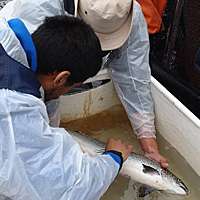Simple test for resistance in lice

The Norwegian Food Safety Authority adopted a field test developed by Kari Olli Helgesen for testing salmon louse resistance to the most common treatments. The method is now being used in Chile as well.
In spring 2012 the aquaculture industry was introduced to a new, simple resistance test that could determine within 24 hours which delousing agent would be most effective.
Kari Olli Helgesen invented the test based on a bioassay developed at the Norwegian School of Veterinary Science, where she is pursuing her doctoral degree.
"This kind of test already existed, but I wanted to improve and simplify the method," Ms Helgesen explains.
"I felt it was important that the test could be carried out with fewer lice than before, using fewer concentrations of medicines, and that it should be possible to validate the test results against the actual effects of treatment."
Cage-side testing
The test, which is done on-site using glass containers, has been well-received by commercial actors and the authorities alike.
In 2013 the Norwegian Food Safety Authority implemented Ms Helgesen's method in its salmon lice monitoring. She is hopeful that the results from reported lice counts before and after treatment will help to validate the bioassay, although she is concerned that changes in the delousing regime in recent years may make validation more difficult.
"Currently, delousing is often done with higher dosages or a mix of medicines. This could mean that the results from the past year's delousing may not be directly applicable, since the assay was developed with the intent to use three different, 'pure' delousing agents," she explains.
Equally high resistance in Chile
Norway is not alone in its salmon lice problems. Conditions in Chilean coastal waters are conducive to parasites, and salmon cages lie close to one another. Ms Helgesen's results are therefore of great interest to the aquaculture industry in Chile, where resistance testing has been uncommon.
"In December 2012 I travelled to Chile and set up a simple laboratory," Ms Helgesen continues. "Test results there showed that resistance among salmon lice in Chile is at least as high as in Norway."
In addition to having developed her own 24-hour bioassay, Ms Helgesen has searched for the genetic causes of resistance in lice. Part of this work involved documenting a new DNA-based resistance test, now patented, developed by PatoGen Analyse.
Provided by The Research Council of Norway












.jpg)





